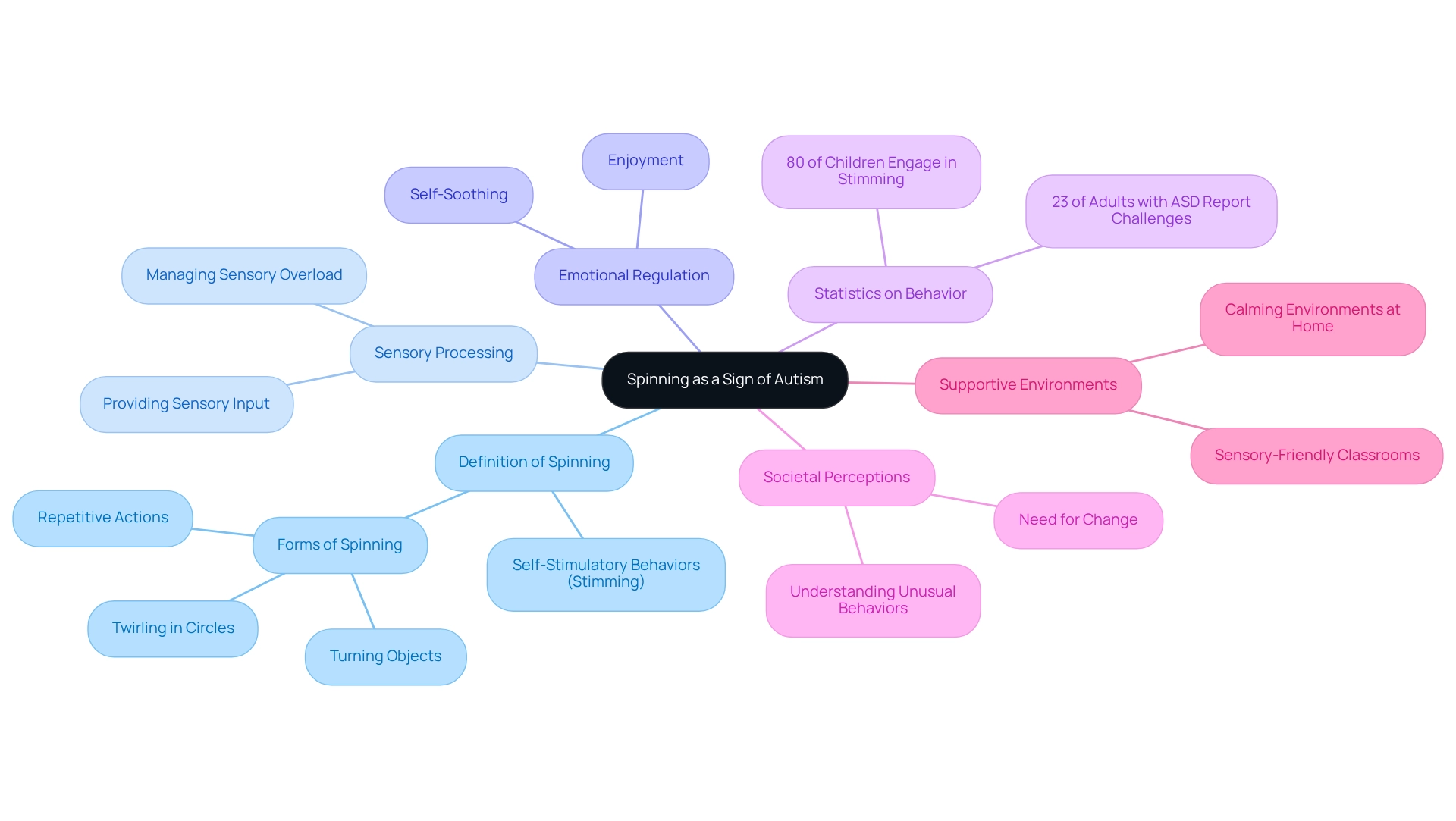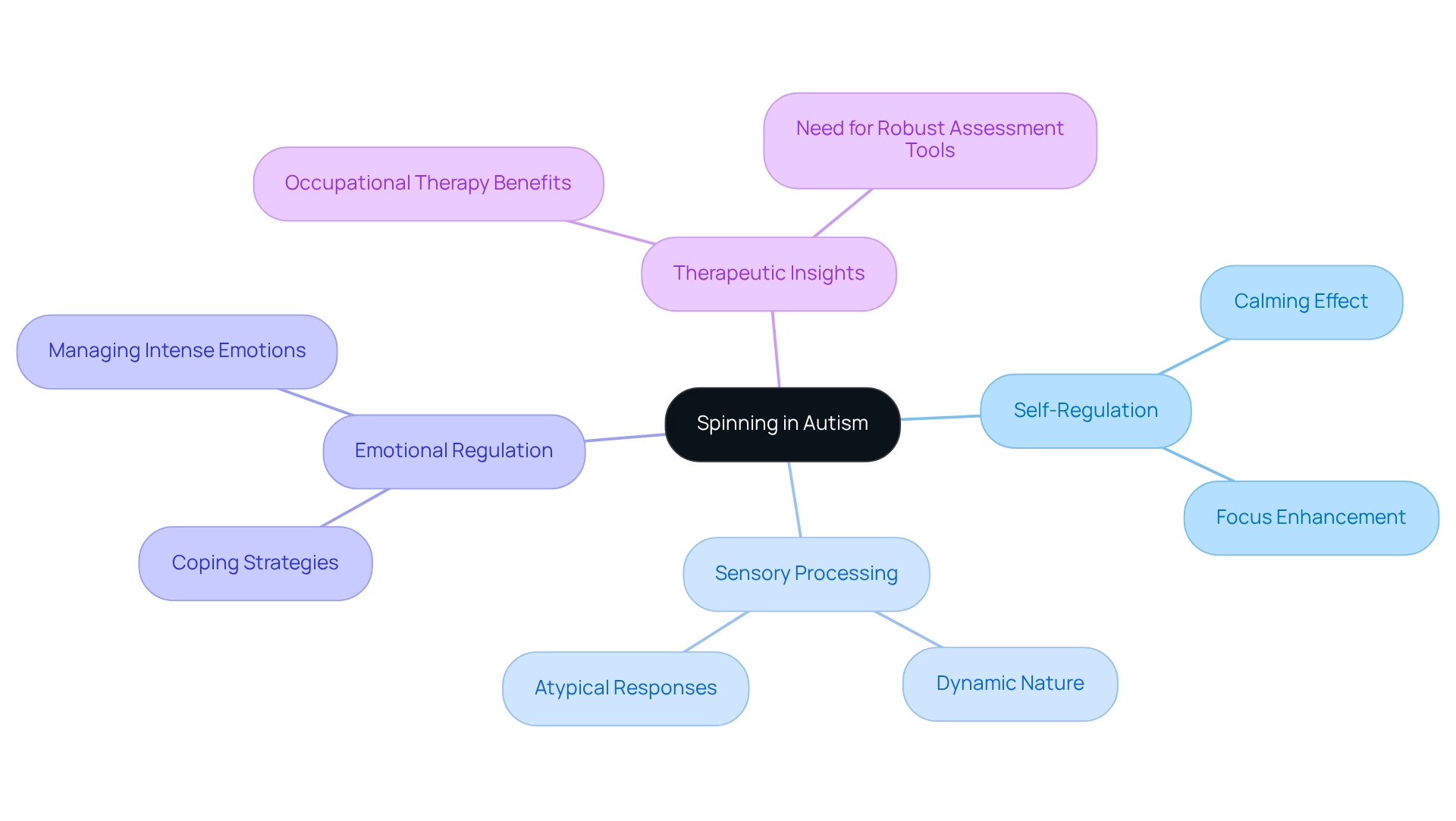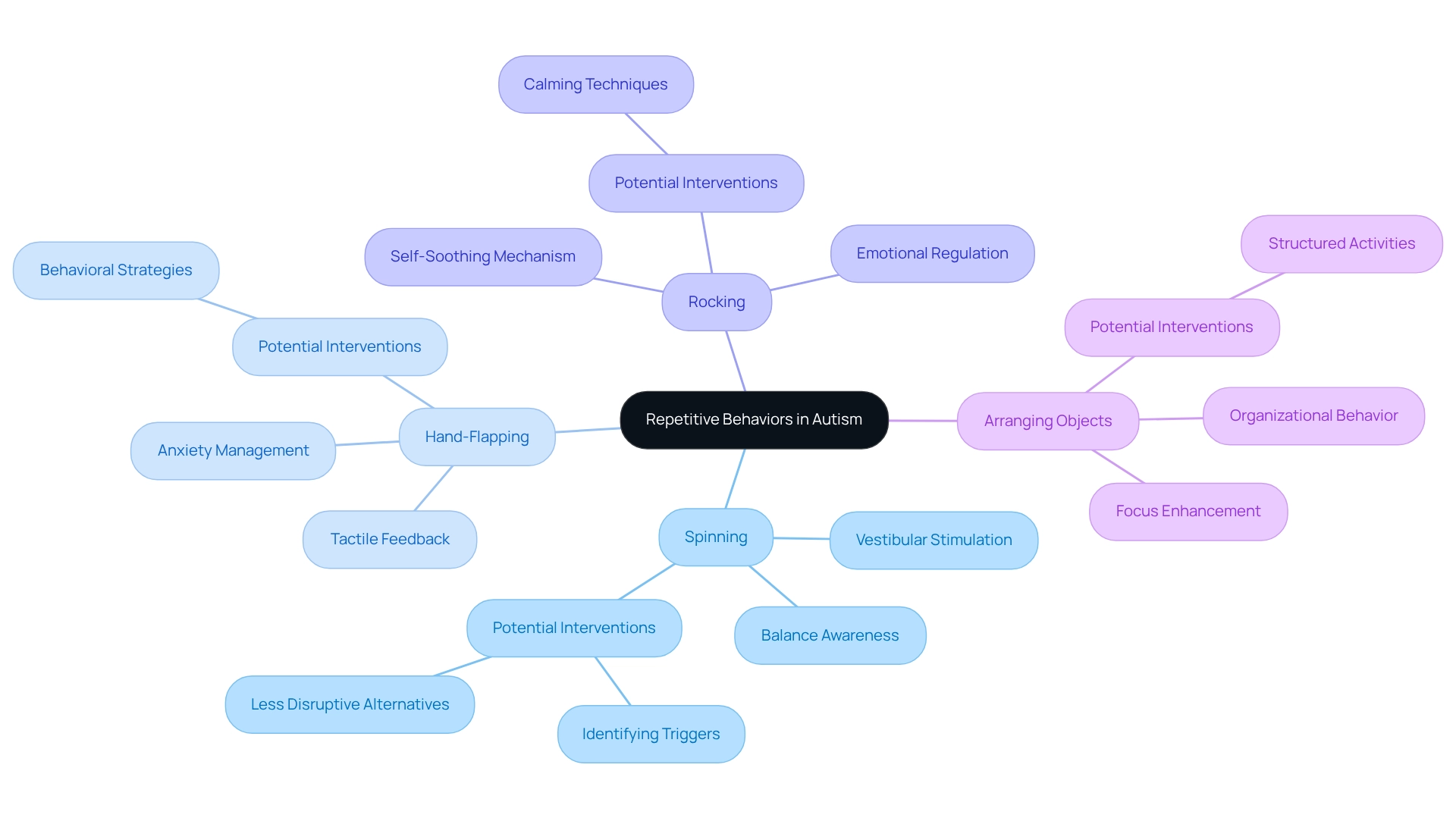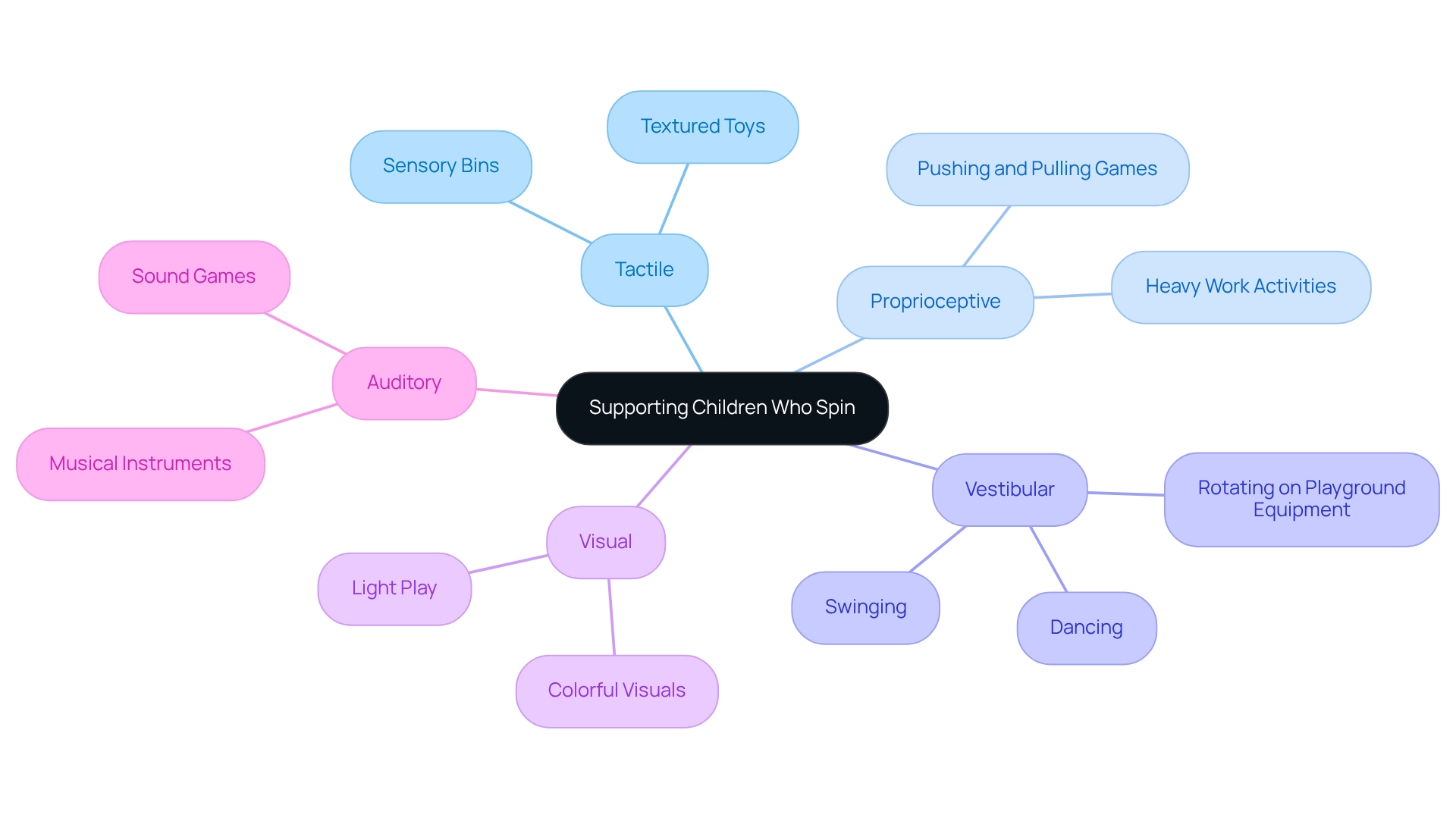Overview
Spinning can be a vital behavior for many children on the autism spectrum, serving essential functions like sensory regulation, emotional self-soothing, and providing vestibular stimulation. These aspects are crucial for their well-being. The prevalence of spinning behaviors among children with autism highlights their importance in managing sensory overload and emotional distress.
Understanding these behaviors is key. They are not merely quirks; they play a significant role in helping children navigate their experiences. As parents, recognizing the value of spinning can foster a more supportive environment for your child. Consider how these behaviors might help them find comfort in overwhelming situations.
By accommodating such behaviors, we can create nurturing spaces that allow children to thrive. Let’s engage in conversations about how we can better support our children and share our experiences. Together, we can foster understanding and compassion in our communities.
Introduction
In the intricate landscape of autism spectrum disorder (ASD), spinning emerges as a fascinating yet often misunderstood behavior. Frequently observed in children on the spectrum, spinning can take various forms—from twirling in circles to rotating objects—and serves multiple purposes that go beyond mere play. This article delves into the significance of spinning, exploring its role in:
- Sensory regulation
- Emotional self-soothing
- Enjoyment
By examining the context of spinning within the broader spectrum of autism, caregivers and professionals can gain valuable insights into how to support and nurture children with these unique needs. As our understanding of autism evolves, recognizing and addressing behaviors like spinning becomes essential in fostering an inclusive and supportive environment for those affected.
Understanding Spinning: A Common Behavior in Autism
Rotating is a behavior often observed in youth with spectrum disorders, and this behavior—spinning—is a sign of autism. It can manifest in various forms, such as twirling in circles, turning objects, or engaging in repetitive actions. These actions fall under the umbrella of self-stimulatory behaviors, commonly referred to as 'stimming.' Studies indicate that approximately 80% of children on the spectrum engage in behaviors that signify autism, underscoring its prevalence within this community.
Understanding that rotational behavior is a sign of autism is crucial for parents and caregivers. It offers valuable insights into a young person's sensory processing and emotional regulation needs. Spinning can serve multiple purposes, including providing sensory input, aiding in self-soothing, or simply offering enjoyment. In some instances, it is indeed a sign of autism.
Recent research has explored the relationship between rotation and sensory processing, particularly examining whether spinning is relevant for youth with autism. These studies suggest that spinning behavior may help young individuals manage sensory overload by providing a consistent and soothing experience. Additionally, experts emphasize the importance of understanding the context of these repetitive actions. They often appear unusual, non-functional, and occur repeatedly, reinforcing the notion that spinning is a sign of autism, as noted by Ericka Wodka, PhD, a pediatric neuropsychologist.
Statistics reveal that a significant number of children with developmental disorders engage in spinning activities. Some studies suggest that around 23% of adults with ASD report that their unique interests, which may indicate spinning as a sign of autism, have led to challenges in social situations. This highlights the urgent need for societal perceptions of such behaviors to evolve, fostering a more supportive environment for autistic individuals.
Moreover, advancements in assessment tools for developmental disorders, like the NIH neurodevelopmental assessment system now available as an iPad app, can aid in comprehending and addressing these behaviors more effectively.
Case studies have shown the benefits of creating sensory-friendly environments, such as calming classrooms equipped with tools and accommodations that support individuals with autism. These settings can help children manage their sensory needs, promoting relaxation and self-regulation. By understanding and supporting spinning activities, caregivers can better assist children in navigating their sensory experiences and emotional responses, reinforcing that spinning is indeed a sign of autism.

Key Characteristics of Autism Spectrum Disorder
Autism spectrum disorder (ASD) encompasses a diverse array of symptoms that can significantly influence social communication, behavior, and sensory processing. Among the key characteristics of ASD are notable challenges in social interactions, often manifested through difficulties in both verbal and nonverbal communication. Children with developmental disorders frequently exhibit limited or repetitive behaviors, including an intense focus on particular interests, strict adherence to routines, and various forms of self-stimulatory activities, commonly known as stimming.
These actions may involve hand-flapping, rocking, and notably, twirling. Understanding these traits is crucial for recognizing how behaviors such as spinning relate to the broader spectrum of developmental disorders. Recent studies indicate that approximately 70% of children with autism face social communication challenges, which can hinder their ability to interact effectively with peers and adults. For instance, a case study on training caregivers highlights the transformative impact of equipping them with skills to assist youth with developmental delays, underscoring the importance of addressing social communication difficulties.
This initiative, detailed in the feature story 'Training caregivers to transform young lives' published on January 28, 2021, showcases ongoing efforts to enhance caregiver training. Experts in the field have noted that social communication difficulties in individuals on the spectrum can manifest in various ways, including challenges in initiating conversations, interpreting social cues, and responding appropriately in social situations. These hurdles not only affect a child's ability to form relationships but also impact their overall development and quality of life. As emphasized by the WHO Comprehensive Mental Health Action Plan, addressing these care deficiencies is essential for promoting inclusion and support for individuals on the spectrum.
Moreover, the average cost of therapeutic behavioral services in the U.S. is $175.44, highlighting the financial challenges families may face when seeking care for individuals with developmental disorders.
As we look ahead to 2025, our understanding of traits related to developmental disorders continues to evolve, with ongoing research shedding light on the complexities of symptoms and behaviors. By recognizing and addressing these vital traits, caregivers and specialists can more effectively support children with developmental disorders, ultimately enhancing their social skills and overall well-being. As Luke Grosvenor, PhD at Kaiser Permanente Northern California, remarked, "Thank you 黄磊, for these insightful comments highlighting both important limitations to our work as well as directions for future research," reinforcing the necessity for continued exploration in this important field.
Common Signs of Autism: Beyond Spinning
Beyond the familiar act of spinning, many other behaviors are often associated with autism spectrum disorder (ASD). These include hand-flapping, echolalia—where young individuals repeat words or phrases they hear—and a deep focus on specific objects or topics. Remarkably, studies indicate that about 30% of youths with developmental disorders may exhibit echolalia, highlighting its frequent role as a means of communication.
Additionally, children with developmental disorders might show signs of social withdrawal. This can appear as difficulty in interpreting social cues or challenges in forming friendships with peers. Recognizing these signs is crucial for early intervention, as timely support can significantly enhance outcomes. The World Health Organization's Comprehensive Mental Health Action Plan 2013–2030 stresses the importance of early detection and care for developmental disorders, underscoring the need to be vigilant in recognizing these signs.
While spinning is a notable behavior, it is essential to understand that it represents just one aspect of autism within the broader spectrum of behaviors associated with the condition. Pediatricians emphasize that early recognition of these signs can lead to more effective intervention strategies, ultimately improving the quality of life for affected youth. For instance, a comprehensive early intervention strategy may include tailored therapies that focus on enhancing communication skills, fostering social interactions, and addressing behavioral challenges, all while creating a supportive environment for individuals with autism.
Moreover, findings from the ADDM Network suggest a rising prevalence of ASD compared to previous assessments, indicating a significant shift in the demographic profile of youth identified with the condition. It is also noteworthy that Black children are more likely to be classified as having intellectual disabilities compared to their Hispanic and White peers, shedding light on potential disparities in diagnosis and intervention. This context reinforces the critical need for awareness and proactive measures in identifying early signs of autism.
Why Do Individuals with Autism Spin? Exploring the Reasons
Youngsters with developmental disorders often engage in rotation, a behavior that can be interpreted as spinning and is frequently associated with autism. This action arises from various motivations, primarily linked to sensory control, emotional comfort, and pleasure. It provides vital vestibular stimulation, which is crucial for sensory processing. Given that approximately 1 in every 36 children in the U.S. is diagnosed with autism, understanding behaviors like whirling is significant for caregivers and professionals alike.
For many children, the repetitive act of twirling can alleviate anxiety and help manage overwhelming sensory stimuli. Additionally, twirling may serve as a unique form of self-expression, allowing young ones to interact with their environment in a way that feels both comfortable and engaging. As highlighted by the Cleveland Clinic, "At Cleveland Clinic, we create compassionate, personalized therapies for them," underscoring the importance of tailored strategies in supporting individuals with autism.
Recognizing these motivations is essential for caregivers, as it enables them to support children effectively and discern when repetitive movements, like spinning, act as coping mechanisms for stress or sensory overload. Furthermore, stimming activities, such as rotating, typically begin in infancy or early childhood, providing a developmental context for these behaviors. Acknowledging that spinning behaviors are linked to autism can significantly enhance the ability to offer personalized support, ultimately fostering a more inclusive environment for individuals on the autism spectrum.
The management of developmental disorders emphasizes that early intervention and customized assistance can greatly benefit autistic children, helping them navigate challenges and build on their strengths.

The Role of Spinning in Self-Regulation and Sensory Processing
For many individuals with autism, spinning serves as a vital sign of autism, playing a crucial role in self-regulation and sensory processing. The rhythmic movement of rotation can effectively organize sensory input, offering a calming effect that significantly aids emotional regulation. For children who experience sensory overload, engaging in rotational activities can be an essential coping strategy, allowing them to manage intense emotions and regain control over their environment.
This behavior not only promotes emotional stability but also enhances focus and concentration, making it an invaluable tool for self-soothing during stressful situations. Insights from occupational therapists indicate that rotational activities can provide sensory benefits, such as improved proprioceptive feedback, which is essential for developing body awareness and coordination. It's important to recognize that sensory processing is dynamic and can fluctuate based on factors like stress, fatigue, or environmental changes, affecting how individuals perceive sensations.
As highlighted in a case study titled "Limitations of Sensory Feature Assessment," the reliance on a single binary sensory variable and high levels of missing data suggest that the prevalence of sensory features may be underestimated. This underscores the need for more robust assessment tools. By understanding that spinning is a sign of autism, caregivers can create supportive environments tailored to these needs, fostering a sense of security and comfort for young individuals navigating the complexities of the condition. As Chade’ Kronby, a college student, shared, 'At a young age I was unable to touch paper or fleece because it was painful,' illustrating the challenges faced by individuals with developmental disorders and the importance of effective self-regulation strategies.

Comparing Spinning to Other Repetitive Behaviors in Autism
One of the repetitive actions often observed in children with autism is spinning. This behavior, along with hand-flapping, rocking, and arranging objects, serves as a sign of autism. While these actions are frequently categorized as forms of self-stimulation or self-soothing, they possess unique characteristics regarding sensory input and emotional regulation. For instance, hand-flapping typically provides tactile feedback that can help young individuals manage anxiety or excitement. In contrast, spinning primarily offers vestibular stimulation, which aids in achieving balance and spatial awareness.
Understanding these differences is crucial for developing tailored interventions and support strategies that cater to each child's unique needs. Research indicates that addressing repetitive behaviors can significantly reduce distractions, enhancing concentration and attention in both learning environments and social interactions. Moreover, managing spinning actions can prevent potential injuries that might lead to hospital visits, underscoring the importance of controlling such behaviors.
A compelling case study highlighted that by effectively managing repetitive actions, children demonstrated increased engagement in school and with their peers. This illustrates the potential benefits of focused interventions.
Additionally, specialists in the field emphasize the importance of recognizing the roles of self-stimulatory actions. A qualified and accredited ABA therapist noted, "A trained and certified ABA therapist can recognize the triggers that lead to spinning," allowing for the implementation of management strategies that offer less disruptive alternatives. This nuanced understanding not only aids in effective behavior management but also fosters a supportive environment where children can thrive emotionally and socially.
Furthermore, it is vital to acknowledge the five potential warning signs for preschoolers related to autism spectrum disorder symptoms. Recognizing these signs can provide additional context for understanding repetitive actions, especially when a child is spinning, which may signify autism.

Supporting Children Who Spin: Practical Guidance for Parents
Supporting a young person engaged in rotational activities requires a deep understanding of their sensory needs. As highlighted by Gersh Academy, some children may need more sensory input than their peers, often leading to a diminished response to sensory stimuli. Parents can create safe zones specifically designed for rotation, allowing children to explore this behavior without the risk of injury.
These designated spaces can feature soft mats or areas where kids can spin freely. Additionally, incorporating structured activities that provide similar sensory experiences—like swinging, rotating on playground equipment, or dancing—can effectively meet sensory needs in a safe environment.
Open communication is vital; parents should discuss spinning behaviors with their children, including conversations about whether spinning might indicate autism. This helps children understand when spinning is appropriate and when it might be disruptive. Such dialogue fosters an environment of understanding and support, enabling young ones to navigate their sensory experiences more effectively.
A case study titled "Activities to Support Sensory Processing" showcases various activities that assist children with sensory processing challenges. These activities are categorized by sensory systems, including:
- tactile
- proprioceptive
- vestibular
- visual
- auditory
The findings reveal that these activities serve as environmental supports, enhancing sensory integration and processing skills during daily routines.
Moreover, research indicates that safe environments for sensory activities significantly benefit children with developmental differences, promoting their overall well-being and growth. ASN provides a comprehensive library of over 1,500 articles, offering a wealth of resources for parents seeking guidance on sensory activities and support. By implementing these strategies, parents can cultivate a nurturing environment that caters to their child's unique sensory needs while encouraging healthy exploration and play.
This guide aims to assist families during challenging times, emphasizing the importance of community and support networks for parents.

Understanding Spinning in the Context of Autism
Spinning is often seen as a sign of autism among individuals with autism spectrum condition, serving multiple functions such as sensory regulation and emotional self-soothing. For parents and caregivers, understanding the context of repetitive behaviors within the broader spectrum of developmental disorders is crucial to providing effective support. Recognizing that spinning is a sign of autism, alongside other typical indicators like hand-flapping and echolalia, offers a more comprehensive view of the actions associated with ASD.
Research indicates that treatment designs tailored to individual behaviors, rather than fixed assumptions, yield more effective outcomes (Repp et al., 1988). This underscores the importance of personalized approaches in understanding and addressing behavioral challenges.
Experts highlight the significance of spinning as a self-regulation tool. For example, an unnamed autistic individual shared, "Spinning is like a reset button for my brain. When I’m overwhelmed or stressed, a quick spin can help me feel calm and ready to face challenges again."
This perspective illustrates how spinning, recognized as a sign of autism, can assist children in managing sensory overload and emotional distress.
Additionally, case studies reveal when professional intervention may be necessary for spinning behaviors. Indicators that suggest a need for professional support include:
- Injury
- Social isolation
- Anxiety-driven spinning
Consulting with experts, such as occupational therapists, can provide tailored evaluations and interventions that balance the acceptance of stimming behaviors with addressing potential concerns.
After identifying triggers, ABA therapists can suggest alternative sensory activities, such as bouncing or specific movement exercises, to fulfill the individual's vestibular stimulation needs.
Ultimately, fostering an environment that supports behaviors linked to individuals on the spectrum, such as recognizing when spinning is a sign of autism, can lead to improved outcomes for children. By embracing these practices and acknowledging their significance, parents and caregivers can create nurturing spaces that promote emotional well-being and developmental growth. Understanding repetitive behaviors in autism is vital for cultivating an inclusive and compassionate society.

Conclusion
Spinning is a behavior that plays a vital role in the lives of many children with autism spectrum disorder (ASD), serving functions that extend far beyond simple play. It facilitates sensory regulation, emotional self-soothing, and enjoyment, highlighting the need for caregivers to understand the significance of this behavior. By recognizing that spinning can help manage sensory overload and provide a calming effect, parents and professionals can better support children in navigating their unique sensory experiences.
The prevalence of spinning among children with autism underscores the importance of addressing this behavior within the broader context of autism characteristics. Understanding how spinning relates to other repetitive behaviors enables caregivers to develop tailored interventions that cater to individual needs. As research continues to evolve, it becomes increasingly clear that creating supportive environments—whether through safe spaces for spinning or structured sensory activities—can significantly enhance the well-being of children on the spectrum.
Ultimately, embracing spinning as an integral part of the autism experience can foster acceptance and understanding in society. By prioritizing the emotional and sensory needs of children with autism, caregivers can help cultivate an inclusive environment that nurtures their strengths while addressing challenges. Recognizing and supporting spinning behaviors is not just about managing a symptom; it is about empowering children to thrive in a world that may often feel overwhelming.
Frequently Asked Questions
What is rotational behavior in youth with spectrum disorders?
Rotational behavior, often observed in youth with autism spectrum disorder (ASD), includes actions such as spinning in circles, turning objects, or engaging in repetitive movements, commonly referred to as 'stimming.'
How prevalent is spinning behavior among children on the autism spectrum?
Studies indicate that approximately 80% of children on the spectrum engage in behaviors that signify autism, including spinning.
What purposes does spinning serve for individuals with autism?
Spinning can provide sensory input, aid in self-soothing, or simply offer enjoyment, and it may help manage sensory overload by providing a consistent and soothing experience.
Why is it important for caregivers to understand rotational behavior?
Understanding rotational behavior is crucial as it offers insights into a young person's sensory processing and emotional regulation needs, allowing caregivers to better support their emotional responses.
What percentage of adults with autism spectrum disorder report challenges related to spinning?
Around 23% of adults with ASD indicate that their unique interests, which may include spinning behaviors, have led to challenges in social situations.
How can advancements in assessment tools help in understanding spinning behaviors?
New assessment tools, like the NIH neurodevelopmental assessment system available as an iPad app, can aid in comprehending and addressing behaviors associated with developmental disorders more effectively.
What are sensory-friendly environments, and how do they benefit children with autism?
Sensory-friendly environments, such as calming classrooms equipped with supportive tools and accommodations, can help children manage their sensory needs, promoting relaxation and self-regulation.
What role does spinning play in the broader context of autism spectrum disorder?
Spinning is a sign of autism and is part of a range of self-stimulatory behaviors that can indicate challenges in social communication and sensory processing among individuals with ASD.




